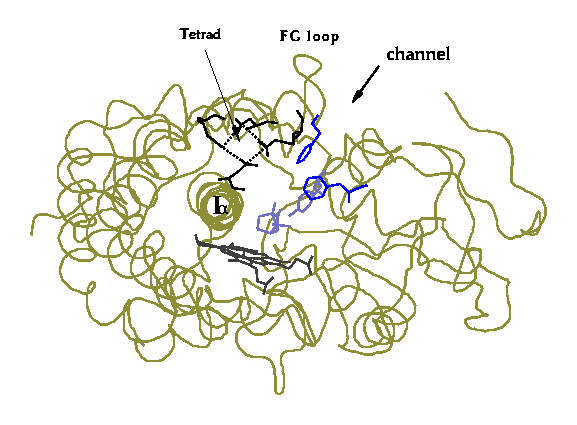
G. Hui Bon Hoa, C. Di Primo, E. Deprez, C. Barret, S. Kozin
INSERM U310, 13 rue Pierre et Marie Curie, 75005 Paris, France
C. Jung, H. Schulze , J. Contzen, C. Mouro
Max Delbrueck Centrum fuer Molekulare Medizin, Robert-Rosslestr. 10, 13122 Berlin, Germany
E. Gill
Dept. of Pharmacology, University of Oxford, England OX1 3QT
G. Simonneaux, A. Bondon, N. LeGrand
URA CNRS 415, University of Rennes I, 35042 Rennes, France
I. Schlichting.
Max Planck Inst. fuer Medizinische Forschung, Heidelberg, Germany, and
Max Planck Inst. fuer Molekulare Physiologie, Rheinlanddamm 201, 44139 Dortmund, Germany.
Cytochrome P450 enzymes are hemoprotein monooxygenases that play a critical role in the synthesis and degradation of many physiologically important compounds and xenobiotics. Essential to the exploitation of P450s, e.g. for large scale synthesis or environmental clean-up, is a thorough knowledge of the structural, energetic, dynamic and functional properties of the enzyme and its interactions with its ligands. Here, we give an overview of the results of interdisciplinary studies aimed at elucidating these properties in the bacterial cytochrome P450cam from Pseudomonas putida.
The active site of P450cam is buried inside the protein and in the crystal structures is inaccessible to the substrate, (1R)-camphor. The mechanism by which camphor reaches the active site is a long-standing puzzle. On the basis of studies of ionic strength and solvent dielectric constant dependence, we have found that there is electrostatic control of substrate access to the active site. Studies with Asp 251, a residue close to a proposed substrate access channel, mutated to Asn show the importance of salt-links to this residue in regulating substrate binding. Electrostatic calculations indicate that cytochrome P450cam has evolved exceptionally strong salt-links to Asp 251 to regulate substrate access to the active site.
By burying its active site, cytochrome P450cam is able to regulate the amount of solvent at the site of catalysis and thereby prevent uncoupling and the production of undesired products. We have used experimental and theoretical methods to examine active site hydration and ligand mobility and their influence on binding affinity and catalytic efficiency. Comparison of the stereoisomers of camphor shows the subtlety with which cytochrome P450cam has optimized its van der Waals interactions with (1R)-camphor. However, a substrate analogue designed to fill space in the active site unoccupied by (1R)-camphor binds cytochrome P450cam with greater affinity than (1R)-camphor. Although Fe spin equilibrium and hydrostatic pressure data indicate that it excludes as much water from the active site as (1R)-camphor, it appears that it may be more mobile in the active site and thus that catalysis is less efficient.
The figure below shows a schematic representation of the crystal structure [8] of cytochrome P450cam. We present our results in their structural context: click on the labels, substrate, cofactor, or parts of the protein about which you would like to know more. (We recommend starting by clicking on "channel" to learn about substrate access to the binding site, and on the substrate structure itself to learn about how ligands bind in the active site).

Figure 1. Schematic diagram of the crystal structure of cytochrome P450cam.
Our data on substrate access to the buried active site of cytochrome P450cam provide support for the location of the access channel in the previously proposed hydrophobic channel next to the F-G loop. They show the importance of salt-links, particularly the unusually stable ones near the proposed entrance channel (Asp251-Lys178, Asp251-Arg186, Arg97-Asp197), in influencing the dynamics of the protein necessary to allow opening of a substrate access channel.
Our data on the binding properties of substrate analogues in the active site of P450cam show that it is possible to design analogues on the basis of the protein structure that bind with greater affinity than the natural substrate. However, catalytic efficiency is not directly correlated with binding affinity and is particularly dependent on active site hydration and ligand mobility.
This work is supported in part by the EU Biotechnology Programme (BIO2-CT94-2060). The assistance of Johnathon Weare in preparing this HTML document is gratefully acknowledged.